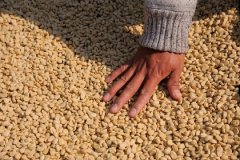How about the cultivation of single bean in Diamond Hill Manor in Costa Rica? single bean harvest in Diamond Hill Manor

For professional baristas, please follow the coffee workshop (Wechat official account cafe_style)
Costa Rica has a population of 41 billion (2006), with a coffee planting area of 82500 hectares and an annual production capacity of 1.7 million bags (60kgs per bag).
The annual domestic consumption is 380000 bags, with an average annual consumption of 5.5kgs per national.
It is higher than Japan's (consumption of 4kgs), and the average Taiwanese are only slightly higher than 1kg.
Costa Rica is the country where coffee was first introduced into Central America. It has a long history and is self-produced by coffee organizations.
Until the sales system is complete. Because it is located in the Central American Gorge, there are many volcanoes in the territory, which has the natural advantages of sunshine and land.
The climate is reconciled by Pacific and Atlantic currents and sea breezes at the same time, and the coffee produced is local.
Due to the characteristics of micro-climate and local conditions, Costa Rican coffee has always been recognized by the world in terms of quality and quantity.
Rated as one of the world-class high-quality coffee. Costa Rican coffee has been grown for 200 years.
Originally planted on the slopes of Poas and Barva volcanoes, it is now known as the Central Valley (Central Valley).
The seven main coffee producing areas are from northwest to southeast, along with the inland central plateau.
The Costa Rican volcanic terrain has fertile volcanic ash, mild and suitable temperatures, and stable and abundant rainfall.
It is one of the reasons why coffee has become one of the main agricultural products in Colombia. The seven major producing areas are: Tarrzu,
Tres Rios 、 Orosi 、 Central Valley 、 West Valley 、 Turrialba 、 Brunca .
Costa Rica has a long history of cultivating coffee, but in the past 10 years, it has been treated by a new "dry" method.
It has become a new method, collectively known as "honey treatment", which uses the scraper to adjust the scraping degree of the pulp.
The output shows "honey" from light to strong with the color from light to dark (white, yellow-red-white, yellow-red-black), with acidity.
Complex aroma, thick feeling... Each has its own depth and advantages.
The seven main coffee producing areas in Costa Rica are from northwest to southeast.
Along with the inland central plateau.
The fertile volcanic ash of Costa Rican volcanic terrain,
Mild and suitable temperature and stable and abundant rainfall
It is one of the reasons why coffee has become one of the main agricultural products in Colombia.
As the coffee industry in Colombia began to develop since the middle of the 18th century.
Coffee was first introduced into Central America to grow.
It has a long history, so the coffee organization has a complete system from production to marketing.
Costa Rican coffee has always been recognized by the world in terms of quality and quantity.
And was rated as a world-class high-quality coffee.
Located in the famous Tarrazu producing area of Costa Rica, it is a world-famous producing area.
The main feature is that the high seafood area creates an incomparable perfect taste.
1800 meters of Diamond Hill in Tarazhu, Costa Rica
Flavor description:
Soft orange notes, sugarcane sweet, toast, clean and bright taste, apricot kernels, cocoa
Everyone's taste is not necessarily what they like.
You can consider buying a small amount and trying different baking degrees.
Soy beans in an explosion
Drop the beans at the end of the explosion.
Drop the beans from the end of the first explosion to the second explosion.
Touch the beans under the second explosion.
Put the beans into the second explosion for 10-15 seconds
The second explosion of dense beans
I hope you bakers can find a more favorite flavor.
*
There's something I need to explain to you.
Coffee beans are agricultural products.
Will vary a little from year to year due to climate change.
If you feel a little different, please forgive me!
Consider other coffee beans next time.
*
The greener the appearance of raw beans, the more moisture.
During the baking process, if the temperature drops too low during an explosion, it may not be cooked enough.
It is recommended to reduce moisture before baking (can be insolated for a few days or use a dehumidifier)
The more whitening parts, the less moisture.
*
Some coffee beans are emerald green and have more flavor after baking.
Some are whitening and taste better after baking.
There are many skills in the baking process.
The same degree of baking but different curves of time and temperature
The taste is also slightly different, and everyone's favorite flavor is not necessarily.
You can try different baking degrees to see which one you prefer.
At the same time, the data of Costa Rican Diamond Hill searched on the Internet are as follows:
ORIGIN: Costa Rica
REGION: Tarrazu
SUBREGION: Dota Valley
PRODUCER: Montanas Del Diamante Estate/Gutierrez Family
PLANT SPECIES: Arabica
PROCESSING METHOD: Washed
PROCESSING DESCRIPTION: The coffee is fully washed and patio dried.
WET MILL NAME: Montanas del Diamante Mill
COFFEE GRADE: SHB EP
SCREEN SIZE: 15 Up
GROWING ALTITUDE: 1750-1850m
ANNUAL RAINFALL (MM): 250
SOIL TYPE: Volcanic
PLANT VARIETAL (S): Red Catuai
TYPES: Estate Coffees, Grain Pro / Ecotact
It is also mentioned on another website that most of the varieties grown here are Red Catuai, a hybrid of Caturra and Mundo Novo. The granules of this batch of raw beans are not large, about 15 mesh. I wonder if they are the characteristics of this variety.
This time it was not very shallow, and the baking degree was about 3 minutes before it was allowed to come down, so the overall acidity is much milder, and the aroma is not very prominent, which can be smelled from raw beans, but the cleanliness of the taste is quite satisfactory, and the supple citrus is sour, which should be acceptable to even friends who don't drink sour coffee very much. The sweetness and cocoa taste of the latter part of the black molasses lasted for a long time before dissipating in the mouth.
In recent years, Costa Rica has not let everyone down, and the Cmax P value has left Guatemala far behind. Whether it is made into a single product or put into a comprehensive formula, it is a good choice.
Costa Rica Costa Rica
Population: 4586000
In the past Costa Rica has successfully sold its coffee according to the name of the region where it is produced. However, tastes vary from region to region, so it is well worth exploring each different region to see what kind of coffee beans they can produce.
CENTRAL VALLEY
The Central Valley, the capital of Costa Rica, San Jose, is located here, which is the most densely populated area. It is also an area that has been growing coffee for the longest time. It is usually divided into subregions of San Jos é Heredia and Alajuela. There are three major volcanoes in the region: lrazu,Barva and Boaz affect topography and soil.
Altitude: 900-1600m
Harvest: November-March
WEST VALLEY
West Valley, the first farmer to settle down in the 19th century, brought coffee. The region is divided into six subregions around the urban centres of San Ramon, Palmares, Naranjo, Greece, Sarchi and Artenas. There is a specific coffee variety in Sarchi called Villa Sarchi. The highest elevation in the area is around Naranjo, and some amazing coffee can be found at the altitude of the area.
Altitude: 700-1600m
Harvest: October-February
TARRAZU
The Tarrazu producing area has a long-standing reputation guarantee, and for many years, the coffee from here can almost be regarded as a high-quality grade. But the coffee comes from different farms and is then mixed into large batches. However, over the years, Tarrazu's brand has accumulated sufficient strength, and coffee produced from outside the region is also marked with Tarrazu to increase its value. Costa Rica's tallest coffee farm is located in this area, like many other areas, where profits are made during the obvious dry season harvest.
Altitude: 1200-1900m
Harvest: November-March
Costa Rica
Costa Rican coffee was first exported in 1820 when it was introduced from Cuba in 1779.
There are about 32000 coffee farmers, with an average planting area of less than one hectare (10000 hectares) per farmer.
Important Notice :
前街咖啡 FrontStreet Coffee has moved to new addredd:
FrontStreet Coffee Address: 315,Donghua East Road,GuangZhou
Tel:020 38364473
- Prev

Costa Rica Diamond Hill Manor single Pin Bean Manor what Diamond Hill Manor single Bean Baking Construction
For the exchange of professional baristas, please follow the coffee workshop (Wechat official account cafe_style). Costa Rica's seven main coffee producing areas are distributed from northwest to southeast along the inland central plateau. Costa Rican volcanic terrain with fertile volcanic ash, mild and suitable temperature, and stable and abundant rainfall is one of the reasons why coffee has become one of the main agricultural products in Costa Rica. Because of Costa Rica
- Next

Costa Rica Diamond Hill Manor single pea how to deal with processing Diamond Villa single bean grade
For the exchange of professional baristas, please follow the coffee workshop (Wechat official account cafe_style) TARRAZU Tarrazu producing area has a long-standing reputation guarantee, for many years the coffee from here can almost be regarded as a high quality grade. But the coffee comes from different farms and is then mixed into large batches. However, over the years, Tarrazu's brand has accumulated sufficient strength from the district
Related
- Does Rose Summer choose Blue, Green or Red? Detailed explanation of Rose Summer Coffee plots and Classification in Panamanian Jade Manor
- What is the difference between the origin, producing area, processing plant, cooperative and manor of coffee beans?
- How fine does the espresso powder fit? how to grind the espresso?
- Sca coffee roasting degree color card coffee roasting degree 8 roasting color values what do you mean?
- The practice of lattes: how to make lattes at home
- Introduction to Indonesian Fine Coffee beans-- Java Coffee producing area of Indonesian Arabica Coffee
- How much will the flavor of light and medium roasted rose summer be expressed? What baking level is rose summer suitable for?
- Introduction to the characteristics of washing, sun-drying or wet-planing coffee commonly used in Mantenin, Indonesia
- Price characteristics of Arabica Coffee Bean Starbucks introduction to Manning Coffee Bean Taste producing area Variety Manor
- What is the authentic Yega flavor? What are the flavor characteristics of the really excellent Yejasuffi coffee beans?

